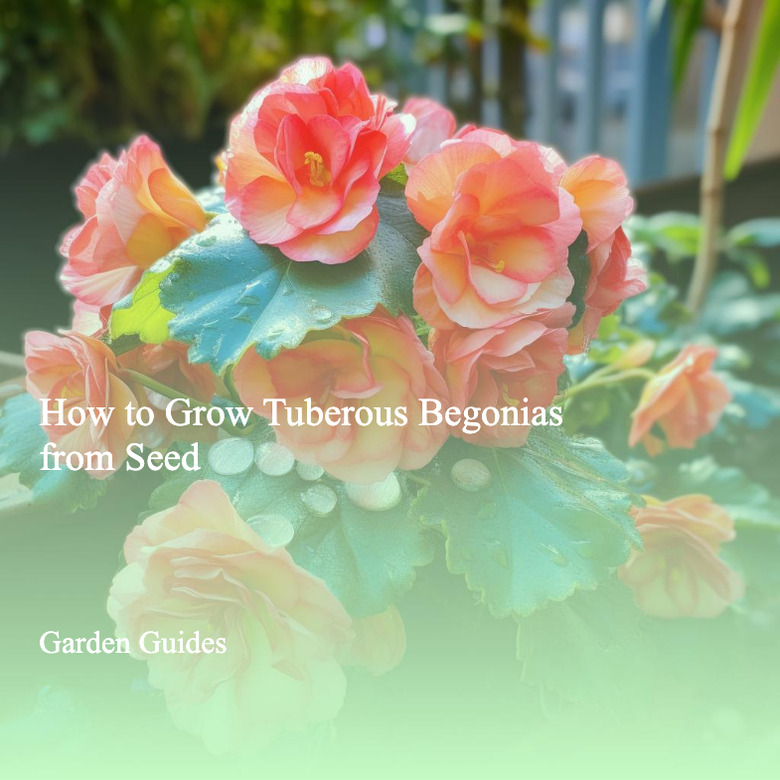How To Grow Tuberous Begonias From Seed
Things Needed
- Container
- Seed-starting mix
- Clear plastic or glass cover
- Seedling pots
- Liquid fertilizer
- Flower fertilizer
Tip
Grow lights may be used to supplement natural light for germination of tuberous begonias. If using glass to cover the germination container, remove and wipe away condensation from the inside at least once per day. This will prevent water droplets from dripping and damaging the delicate begonia seeds.
Warning
Never allow tuberous begonias to become waterlogged or mildew and rot can develop.
Growing tuberous begonias from seed takes a little more effort than beginning with started plants or tubers. However, if started in winter, the plants will reward you with large, colorful blooms the following summer. Tuberous begonias are prized for their flowers, which can be single or double and come in colors of white, yellow, orange, pink and red. Seeds are typically available in garden centers or through seed catalogs year-round. Start tuberous begonia seeds indoors in December or January for summer blooms.
Step 1
Add 1 inch of sterile seed-starting mix to a shallow growing container and add water to moisten. The mixture should not be wet or soggy. Allow it to drain thoroughly after watering and before planting the seeds for best results.
- Growing tuberous begonias from seed takes a little more effort than beginning with started plants or tubers.
Step 2
Scatter the tiny seeds across the surface of the soil, but do not attempt to cover them with soil. Cover the container with clear glass or plastic, or place the entire container into a zipper-lock plastic bag to retain moisture.
Step 3
Place the covered container in an area where it will receive at least 14 hours of indirect sunlight each day.
Step 4
Keep the temperature of the tuberous begonia seeds at 65 to 70 degrees Fahrenheit at all times. Germination will take place in seven to 10 days. Remove the covering or open the plastic bag for a few hours each day to aerate the seeds. Make sure to re-cover before darkness falls.
- Scatter the tiny seeds across the surface of the soil, but do not attempt to cover them with soil.
- Remove the covering or open the plastic bag for a few hours each day to aerate the seeds.
Step 5
Remove the plastic or glass covering completely two days after the tuberous begonia seeds have germinated. Continue providing 14 hours of light per day for an additional three weeks, until true leaves begin to form.
Step 6
Water the soil once per week from the bottom to keep the soil consistently moist while the plants are developing.
Step 7
Transplant the tuberous begonia seedlings to small seedling pots filled with sterile seed-starting mix once they've reached 3 to 4 inches in height. Space plants at least 2 inches apart in the pots, or allow each plant its own container for better results. Lower temperatures to 65 degrees Fahrenheit during the day and 55 degrees Fahrenheit at night.
Step 8
Feed the tuberous begonia seedlings with a diluted liquid fertilizer a few days after transplanting to encourage growth. Refer to the manufacturer's instructions and apply the fertilizer diluted to 1/4 full strength to prevent leaf or root burn of the tender seedlings. Water thoroughly before and after application.
- Remove the plastic or glass covering completely two days after the tuberous begonia seeds have germinated.
Step 9
Transfer the tuberous begonias outdoors when all danger of frost has passed and the nighttime temperatures are above 50 degrees Fahrenheit. Choose a planting site with well-drained soil and indirect sunlight for most of the day. Do not plant in full sun or full shade. Space plants 8 to 12 inches apart.
Step 10
Water tuberous begonias once per week to keep the soil consistently moist, but only on weeks that do not receive rainfall. Feed once per month with an all-purpose flower fertilizer according to the manufacturer's directions. Pinch back flower buds that occur in early spring, but allow any buds that form in early summer to remain.
- Transfer the tuberous begonias outdoors when all danger of frost has passed and the nighttime temperatures are above 50 degrees Fahrenheit.
- Water tuberous begonias once per week to keep the soil consistently moist, but only on weeks that do not receive rainfall.
References
- Yard & Garden Brief: Tuberous Begonias
- Book: Bulbs; John E. Bryan; 2002
